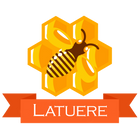For centuries, Granada has had marked characteristics for beekeeping.There are numerous citations that speak of the abundant production of aromatic and medicinal plants, many of them melliferous, as stated by Ahamd ben Muhammad ben Musa Al-Razi (885-955) in his description of Elvira (Granada) when he speaks of Sierra Snowfall..

Beekeepers in many cases had to carry out their activity in desolate mountains, many of them bordering kingdoms, not exempt from dangers and bandits.For this reason, since approximately the 13th century (year 1220) they are organized, creating the Santa Hermandad Vieja (Toledo).This was a powerful organization of a military nature, where all the brothers were beekeepers, and it was mandatory to have 1 or 2 inns with populated hives, weapons and a dog.

Already Ibn al-Jathib (1313-1375) in his "Description of the Kingdom of Granada, under the domination of the Naserites, taken from Arab authors", tells us about the abundance of honey production in Granada in areas that even today preserve this traditional resource as an important source of income.

During the conquest of the kingdom of Granada by the Christian troops, many chronicles were written where continuous allusions are made to the abundance and excellence of the honey of the Kingdom of Granada. Thus, during the continuous seizures and defense of Alhama de Granada, Mosen Diego de Valera comments that “...infinite wheat, barley, chickpeas, beans, honey and oil were found.”, or Hernando Pérez del Pulgar says that “... Some knights and peons, thinking that the city could not be sustained and that they had to abandon it, broke many jars of oil and honey...”. Or D. Rodrigo Ponce de León, Marquis of Cádiz, where he once again cites the cities of Alhama, Loja and Illora for their abundance of honey.
Henriquez de Jorquera, in his “Annals of Granada. Description of the kingdom and city of Granada. Chronicle of the Reconquest (1482-1492). Events of the years 1588 to 1646 ", reiterates the importance in terms of honey production in the Kingdom of Granada, speaking of areas with abundant honey Sierra Nevada (Monachil) and especially the Baza area, where he asserts that “a very white and very soft honey, the best in the kingdom” is obtained from Granada, alluding to rosemary honey.

After the conquest, the municipalities began to organize the various economic activities.Thus in Baza, in the Own Book of the year 1564, the City Council charged herbage for the hives that were in the Sierra de Baza, rosemary honey having deserved fame.

In the book of trades of the city of Granada (1752), the "Beehive Breeder" was expressly included, with authentic professionals such as Mathías Mendez from the Parish of San Miguel with more than 500 hives.
In 1752 Ferdinand VI ordered all the information of the Kingdom to be compiled for a reform of the fiscal regime, the Marquis of Ensenada taking charge of it. Mr. Luis González de Aguilar-Torres Navarra (Marqués de Campo Verde) was responsible for the Cadastre of Ensenada in Granada. Question 19 is dedicated exclusively to the hives indicating their number and those who rented the honey and wax. From the data extracted from the Books of General and Particular Answers of the aforementioned census, we found that more than 882 beekeepers were dedicated to the profession at that time and there were no less than 10,231 hives, distributed throughout the northern area of Granada (Baza), the Costa , Sierra Nevada, Las Alpujarras and Montes Orientales.

Various authors in works on geography point out the production and fame of honey in Granada.Thus Juan de la Serna (1777) when he speaks of Granada says that it is rich in wax and honey, Sebastián de Miñano (1826) points to Baza, Alhama de Granada, Güejar-Sierra, and Guadix as important honey production areas in Granada. .Pascual Madoz, in his "Geographical, Statistical and Historical Dictionary of Spain" highlights the variety, abundance and excellence of Honey from Granada, thus commenting that white honey is very abundant in the term and Loja.Or as on the Coast (La Garnatilla and Motril) honey production is important, there is also a rum factory of excellent quality since it supplies these honeys and received a quality award at the 1828 Exhibition.

Luis Morell and Terry (1888) carried out a census, estimating the number of hives at about 15,000, maintaining the traditional areas in terms of the number of hives. The eastern mountains (Loja, Montefrío and Iznalloz), Las Alpujarras (Partido de Orgiva) and Granada capital.
That same year, 1888, Ms. Bertha Wihelmi, a lady of German origin living in Granada, became a key element in the modernization of the sector in the province. Ms. Berta, among many other important activities, was a beekeeper and owned several apiaries in Granada, introducing and spreading mobile frame hives in the province, with the gradual replacement of traditional fixist hives (Arabs)
Granada thus becomes, by the hand of Dª Bertha, one of the pioneering provinces and promoters of the development of new beekeeping techniques.

In May 1909, the Granada Agrícola newspaper echoes the interest shown by the German market in importing honey from Granada to that country based on its quality, given the rich flora of aromatic and medicinal plants that populate its mountains, especially Sierra Snowfall.

Throughout this last century the number of hives has not stopped increasing to the current 40,000.



